MG412 Principles of Marketing: A Detailed Dyson Brand Extension Report
VerifiedAdded on 2023/06/16
|15
|2056
|378
Report
AI Summary
This report examines a brand extension strategy for Dyson, a technology-based company, using marketing principles. It includes a PESTEL analysis and Ansoff model to develop a new product, specifically a hair dryer, within Dyson's existing product line. The study uses Kapferer’s Brand Identity Prism to assess the brand's market share and values, targeting middle to high-income consumers aged 25-45. The report also covers market segmentation, positioning, competitive analysis with companies like Samsung and Bosch, and proposes a product development strategy with innovative features and unique packaging. The analysis aims to provide a comprehensive marketing plan for Dyson's brand extension, emphasizing product differentiation and market leadership.
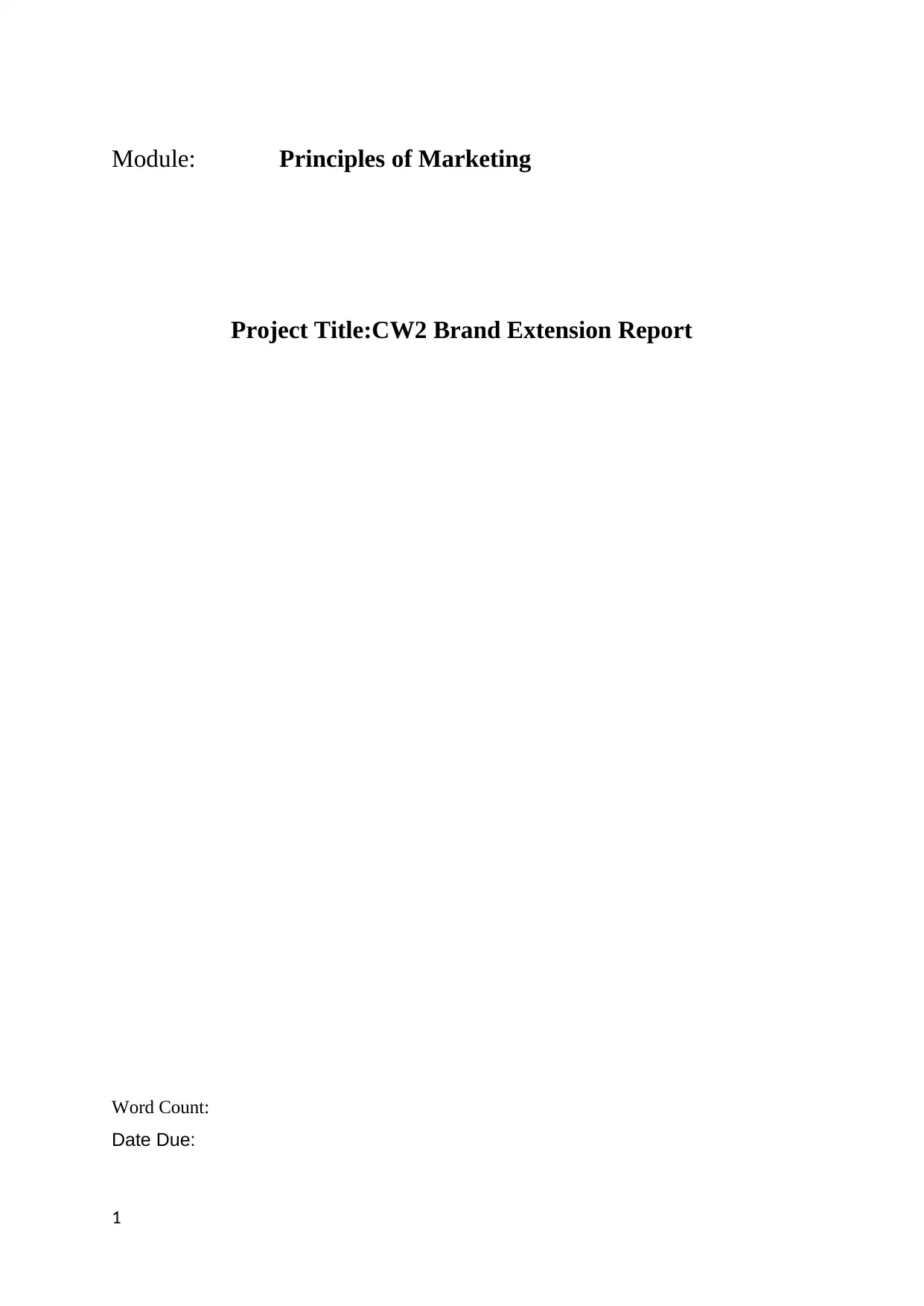
Module: Principles of Marketing
Project Title:CW2 Brand Extension Report
Word Count:
Date Due:
1
Project Title:CW2 Brand Extension Report
Word Count:
Date Due:
1
Paraphrase This Document
Need a fresh take? Get an instant paraphrase of this document with our AI Paraphraser
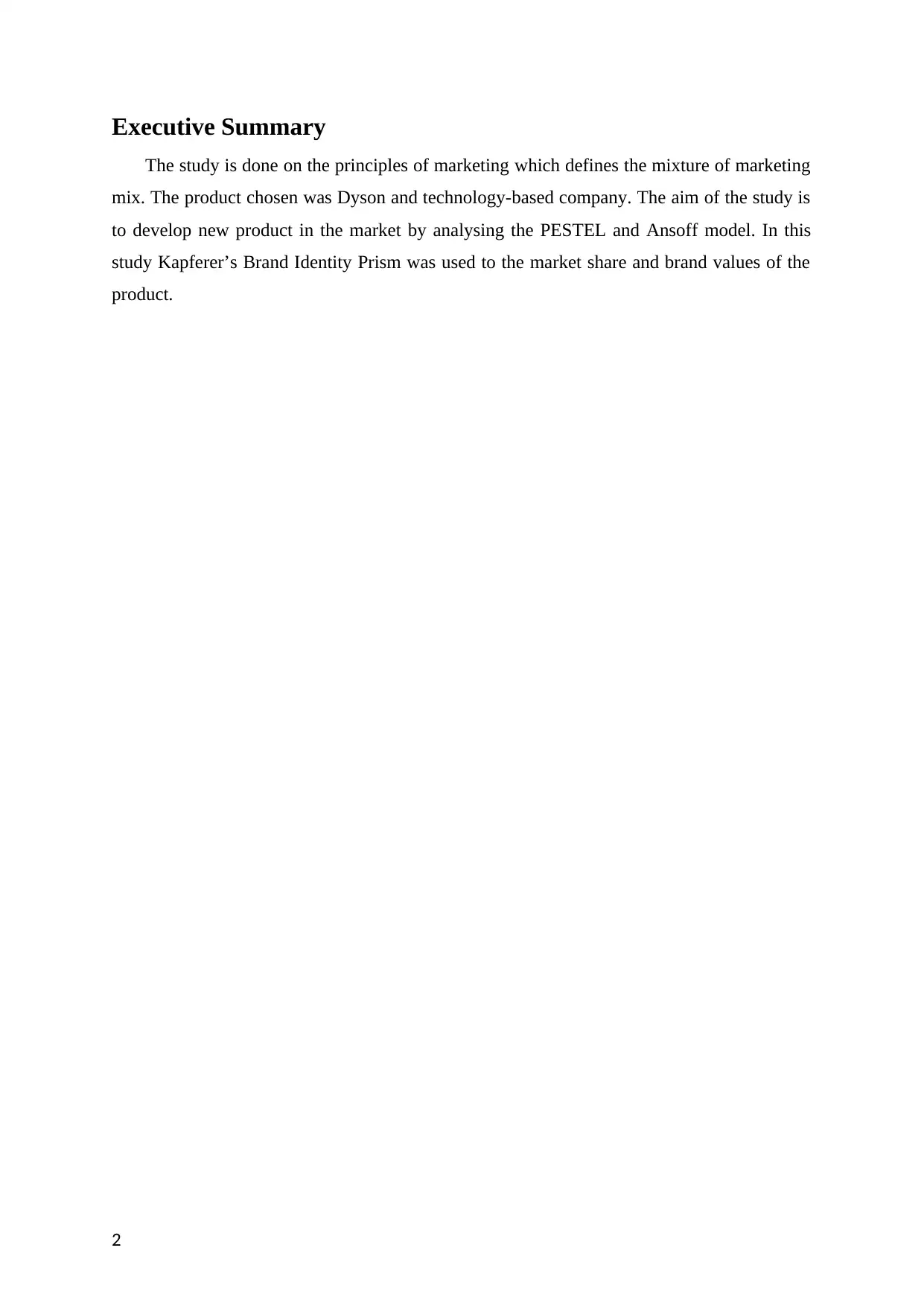
Executive Summary
The study is done on the principles of marketing which defines the mixture of marketing
mix. The product chosen was Dyson and technology-based company. The aim of the study is
to develop new product in the market by analysing the PESTEL and Ansoff model. In this
study Kapferer’s Brand Identity Prism was used to the market share and brand values of the
product.
2
The study is done on the principles of marketing which defines the mixture of marketing
mix. The product chosen was Dyson and technology-based company. The aim of the study is
to develop new product in the market by analysing the PESTEL and Ansoff model. In this
study Kapferer’s Brand Identity Prism was used to the market share and brand values of the
product.
2
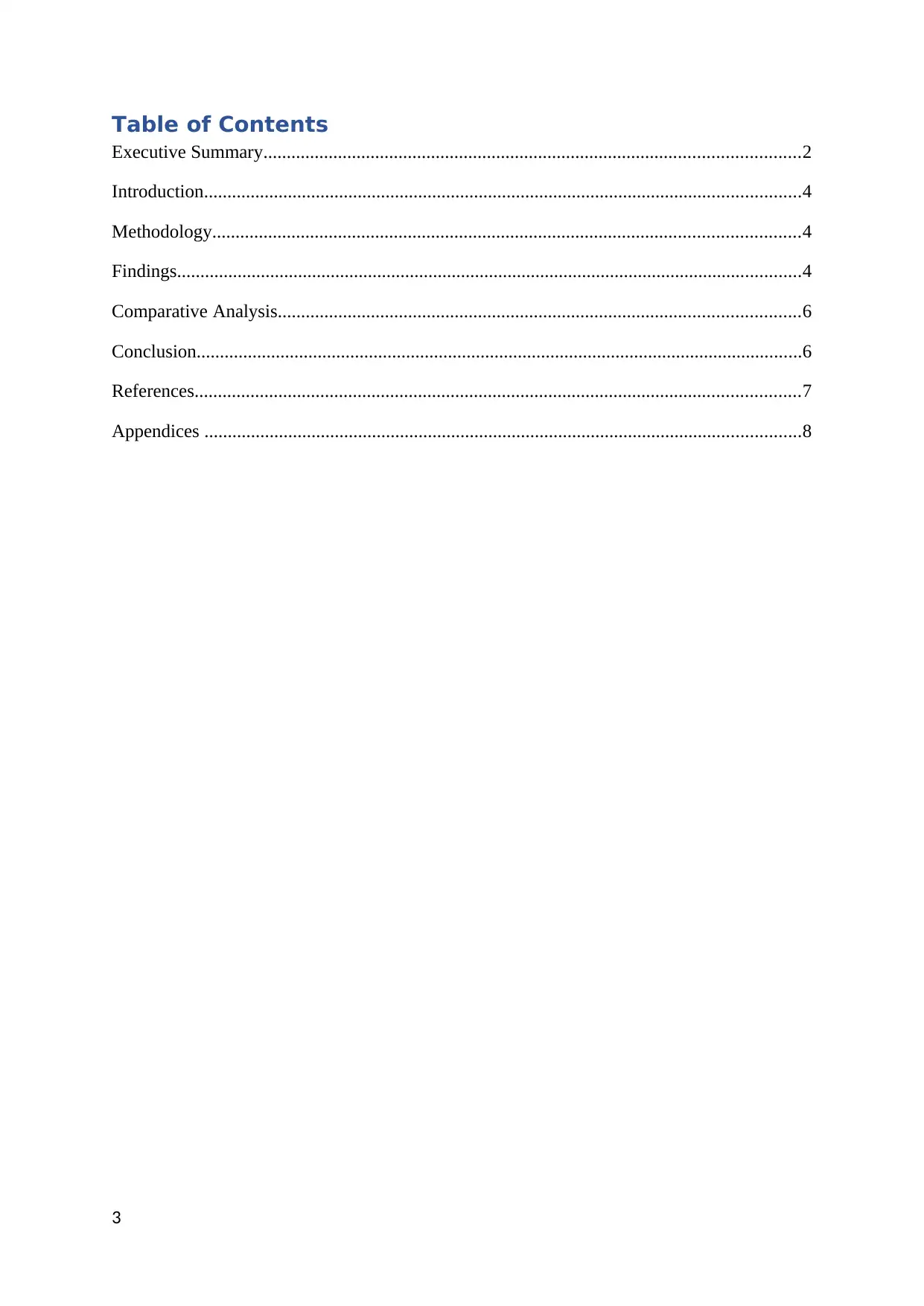
Table of Contents
Executive Summary...................................................................................................................2
Introduction................................................................................................................................4
Methodology..............................................................................................................................4
Findings......................................................................................................................................4
Comparative Analysis................................................................................................................6
Conclusion..................................................................................................................................6
References..................................................................................................................................7
Appendices ................................................................................................................................8
3
Executive Summary...................................................................................................................2
Introduction................................................................................................................................4
Methodology..............................................................................................................................4
Findings......................................................................................................................................4
Comparative Analysis................................................................................................................6
Conclusion..................................................................................................................................6
References..................................................................................................................................7
Appendices ................................................................................................................................8
3
⊘ This is a preview!⊘
Do you want full access?
Subscribe today to unlock all pages.

Trusted by 1+ million students worldwide
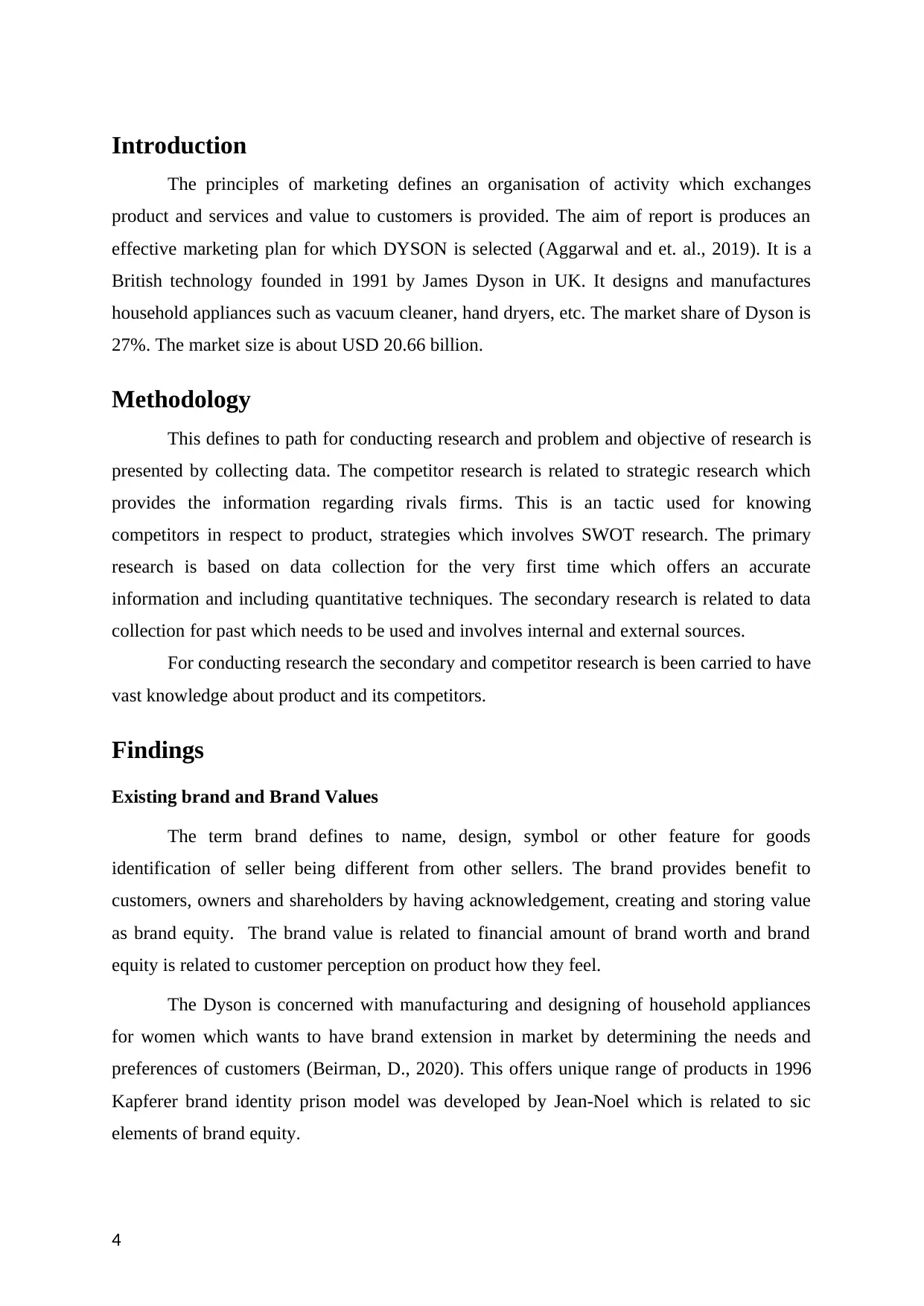
Introduction
The principles of marketing defines an organisation of activity which exchanges
product and services and value to customers is provided. The aim of report is produces an
effective marketing plan for which DYSON is selected (Aggarwal and et. al., 2019). It is a
British technology founded in 1991 by James Dyson in UK. It designs and manufactures
household appliances such as vacuum cleaner, hand dryers, etc. The market share of Dyson is
27%. The market size is about USD 20.66 billion.
Methodology
This defines to path for conducting research and problem and objective of research is
presented by collecting data. The competitor research is related to strategic research which
provides the information regarding rivals firms. This is an tactic used for knowing
competitors in respect to product, strategies which involves SWOT research. The primary
research is based on data collection for the very first time which offers an accurate
information and including quantitative techniques. The secondary research is related to data
collection for past which needs to be used and involves internal and external sources.
For conducting research the secondary and competitor research is been carried to have
vast knowledge about product and its competitors.
Findings
Existing brand and Brand Values
The term brand defines to name, design, symbol or other feature for goods
identification of seller being different from other sellers. The brand provides benefit to
customers, owners and shareholders by having acknowledgement, creating and storing value
as brand equity. The brand value is related to financial amount of brand worth and brand
equity is related to customer perception on product how they feel.
The Dyson is concerned with manufacturing and designing of household appliances
for women which wants to have brand extension in market by determining the needs and
preferences of customers (Beirman, D., 2020). This offers unique range of products in 1996
Kapferer brand identity prison model was developed by Jean-Noel which is related to sic
elements of brand equity.
4
The principles of marketing defines an organisation of activity which exchanges
product and services and value to customers is provided. The aim of report is produces an
effective marketing plan for which DYSON is selected (Aggarwal and et. al., 2019). It is a
British technology founded in 1991 by James Dyson in UK. It designs and manufactures
household appliances such as vacuum cleaner, hand dryers, etc. The market share of Dyson is
27%. The market size is about USD 20.66 billion.
Methodology
This defines to path for conducting research and problem and objective of research is
presented by collecting data. The competitor research is related to strategic research which
provides the information regarding rivals firms. This is an tactic used for knowing
competitors in respect to product, strategies which involves SWOT research. The primary
research is based on data collection for the very first time which offers an accurate
information and including quantitative techniques. The secondary research is related to data
collection for past which needs to be used and involves internal and external sources.
For conducting research the secondary and competitor research is been carried to have
vast knowledge about product and its competitors.
Findings
Existing brand and Brand Values
The term brand defines to name, design, symbol or other feature for goods
identification of seller being different from other sellers. The brand provides benefit to
customers, owners and shareholders by having acknowledgement, creating and storing value
as brand equity. The brand value is related to financial amount of brand worth and brand
equity is related to customer perception on product how they feel.
The Dyson is concerned with manufacturing and designing of household appliances
for women which wants to have brand extension in market by determining the needs and
preferences of customers (Beirman, D., 2020). This offers unique range of products in 1996
Kapferer brand identity prison model was developed by Jean-Noel which is related to sic
elements of brand equity.
4
Paraphrase This Document
Need a fresh take? Get an instant paraphrase of this document with our AI Paraphraser
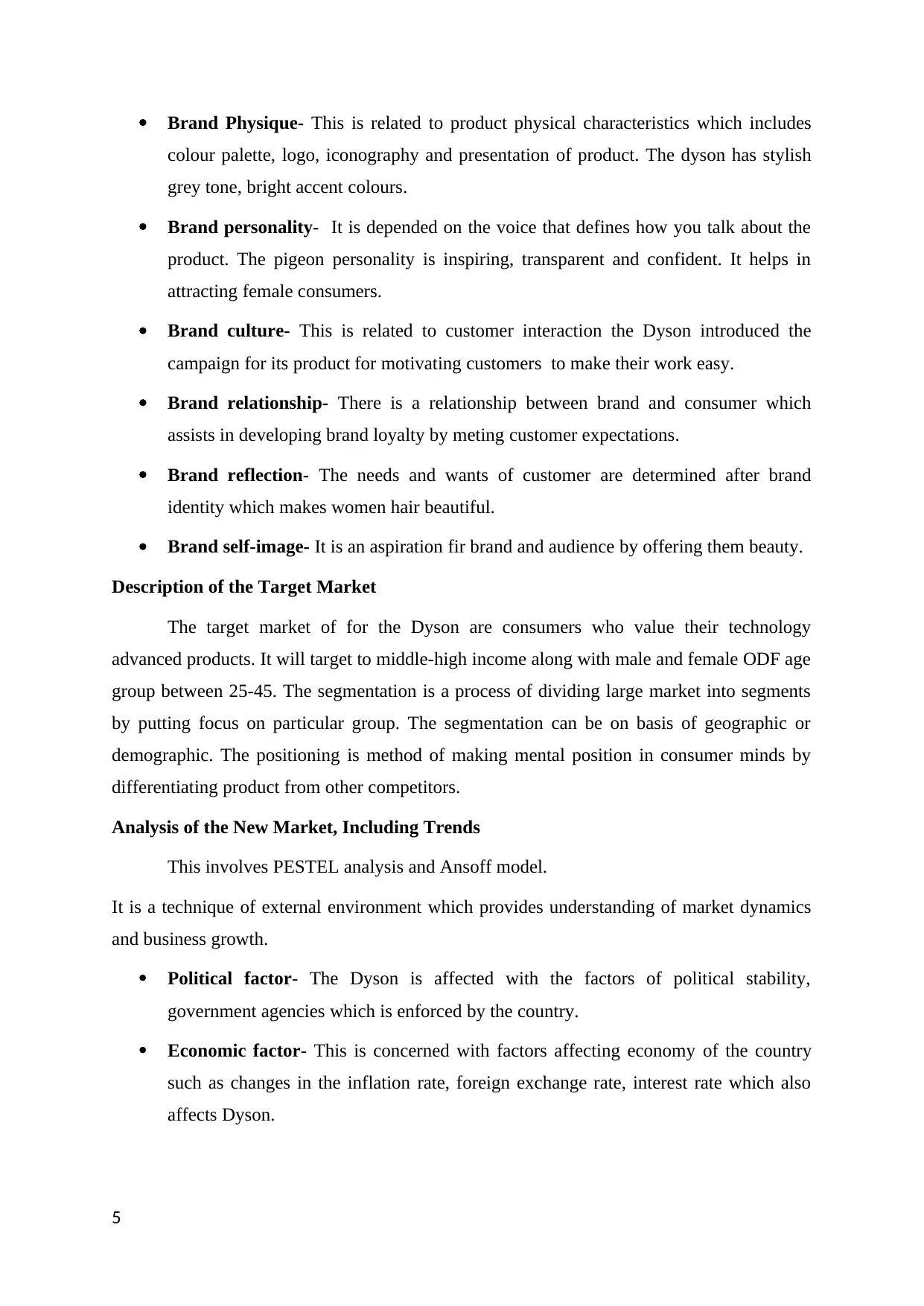
Brand Physique- This is related to product physical characteristics which includes
colour palette, logo, iconography and presentation of product. The dyson has stylish
grey tone, bright accent colours.
Brand personality- It is depended on the voice that defines how you talk about the
product. The pigeon personality is inspiring, transparent and confident. It helps in
attracting female consumers.
Brand culture- This is related to customer interaction the Dyson introduced the
campaign for its product for motivating customers to make their work easy.
Brand relationship- There is a relationship between brand and consumer which
assists in developing brand loyalty by meting customer expectations.
Brand reflection- The needs and wants of customer are determined after brand
identity which makes women hair beautiful.
Brand self-image- It is an aspiration fir brand and audience by offering them beauty.
Description of the Target Market
The target market of for the Dyson are consumers who value their technology
advanced products. It will target to middle-high income along with male and female ODF age
group between 25-45. The segmentation is a process of dividing large market into segments
by putting focus on particular group. The segmentation can be on basis of geographic or
demographic. The positioning is method of making mental position in consumer minds by
differentiating product from other competitors.
Analysis of the New Market, Including Trends
This involves PESTEL analysis and Ansoff model.
It is a technique of external environment which provides understanding of market dynamics
and business growth.
Political factor- The Dyson is affected with the factors of political stability,
government agencies which is enforced by the country.
Economic factor- This is concerned with factors affecting economy of the country
such as changes in the inflation rate, foreign exchange rate, interest rate which also
affects Dyson.
5
colour palette, logo, iconography and presentation of product. The dyson has stylish
grey tone, bright accent colours.
Brand personality- It is depended on the voice that defines how you talk about the
product. The pigeon personality is inspiring, transparent and confident. It helps in
attracting female consumers.
Brand culture- This is related to customer interaction the Dyson introduced the
campaign for its product for motivating customers to make their work easy.
Brand relationship- There is a relationship between brand and consumer which
assists in developing brand loyalty by meting customer expectations.
Brand reflection- The needs and wants of customer are determined after brand
identity which makes women hair beautiful.
Brand self-image- It is an aspiration fir brand and audience by offering them beauty.
Description of the Target Market
The target market of for the Dyson are consumers who value their technology
advanced products. It will target to middle-high income along with male and female ODF age
group between 25-45. The segmentation is a process of dividing large market into segments
by putting focus on particular group. The segmentation can be on basis of geographic or
demographic. The positioning is method of making mental position in consumer minds by
differentiating product from other competitors.
Analysis of the New Market, Including Trends
This involves PESTEL analysis and Ansoff model.
It is a technique of external environment which provides understanding of market dynamics
and business growth.
Political factor- The Dyson is affected with the factors of political stability,
government agencies which is enforced by the country.
Economic factor- This is concerned with factors affecting economy of the country
such as changes in the inflation rate, foreign exchange rate, interest rate which also
affects Dyson.
5
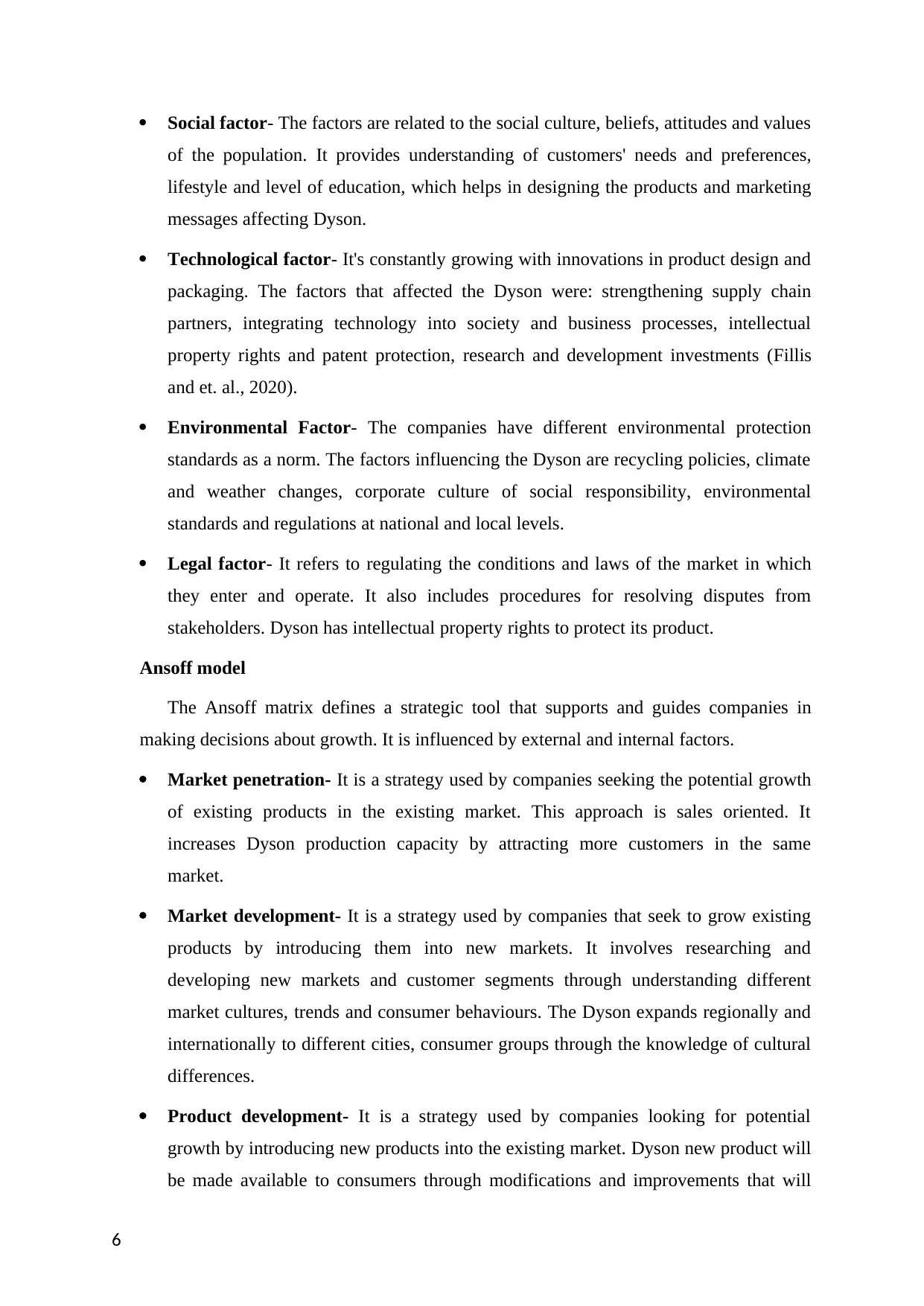
Social factor- The factors are related to the social culture, beliefs, attitudes and values
of the population. It provides understanding of customers' needs and preferences,
lifestyle and level of education, which helps in designing the products and marketing
messages affecting Dyson.
Technological factor- It's constantly growing with innovations in product design and
packaging. The factors that affected the Dyson were: strengthening supply chain
partners, integrating technology into society and business processes, intellectual
property rights and patent protection, research and development investments (Fillis
and et. al., 2020).
Environmental Factor- The companies have different environmental protection
standards as a norm. The factors influencing the Dyson are recycling policies, climate
and weather changes, corporate culture of social responsibility, environmental
standards and regulations at national and local levels.
Legal factor- It refers to regulating the conditions and laws of the market in which
they enter and operate. It also includes procedures for resolving disputes from
stakeholders. Dyson has intellectual property rights to protect its product.
Ansoff model
The Ansoff matrix defines a strategic tool that supports and guides companies in
making decisions about growth. It is influenced by external and internal factors.
Market penetration- It is a strategy used by companies seeking the potential growth
of existing products in the existing market. This approach is sales oriented. It
increases Dyson production capacity by attracting more customers in the same
market.
Market development- It is a strategy used by companies that seek to grow existing
products by introducing them into new markets. It involves researching and
developing new markets and customer segments through understanding different
market cultures, trends and consumer behaviours. The Dyson expands regionally and
internationally to different cities, consumer groups through the knowledge of cultural
differences.
Product development- It is a strategy used by companies looking for potential
growth by introducing new products into the existing market. Dyson new product will
be made available to consumers through modifications and improvements that will
6
of the population. It provides understanding of customers' needs and preferences,
lifestyle and level of education, which helps in designing the products and marketing
messages affecting Dyson.
Technological factor- It's constantly growing with innovations in product design and
packaging. The factors that affected the Dyson were: strengthening supply chain
partners, integrating technology into society and business processes, intellectual
property rights and patent protection, research and development investments (Fillis
and et. al., 2020).
Environmental Factor- The companies have different environmental protection
standards as a norm. The factors influencing the Dyson are recycling policies, climate
and weather changes, corporate culture of social responsibility, environmental
standards and regulations at national and local levels.
Legal factor- It refers to regulating the conditions and laws of the market in which
they enter and operate. It also includes procedures for resolving disputes from
stakeholders. Dyson has intellectual property rights to protect its product.
Ansoff model
The Ansoff matrix defines a strategic tool that supports and guides companies in
making decisions about growth. It is influenced by external and internal factors.
Market penetration- It is a strategy used by companies seeking the potential growth
of existing products in the existing market. This approach is sales oriented. It
increases Dyson production capacity by attracting more customers in the same
market.
Market development- It is a strategy used by companies that seek to grow existing
products by introducing them into new markets. It involves researching and
developing new markets and customer segments through understanding different
market cultures, trends and consumer behaviours. The Dyson expands regionally and
internationally to different cities, consumer groups through the knowledge of cultural
differences.
Product development- It is a strategy used by companies looking for potential
growth by introducing new products into the existing market. Dyson new product will
be made available to consumers through modifications and improvements that will
6
⊘ This is a preview!⊘
Do you want full access?
Subscribe today to unlock all pages.

Trusted by 1+ million students worldwide
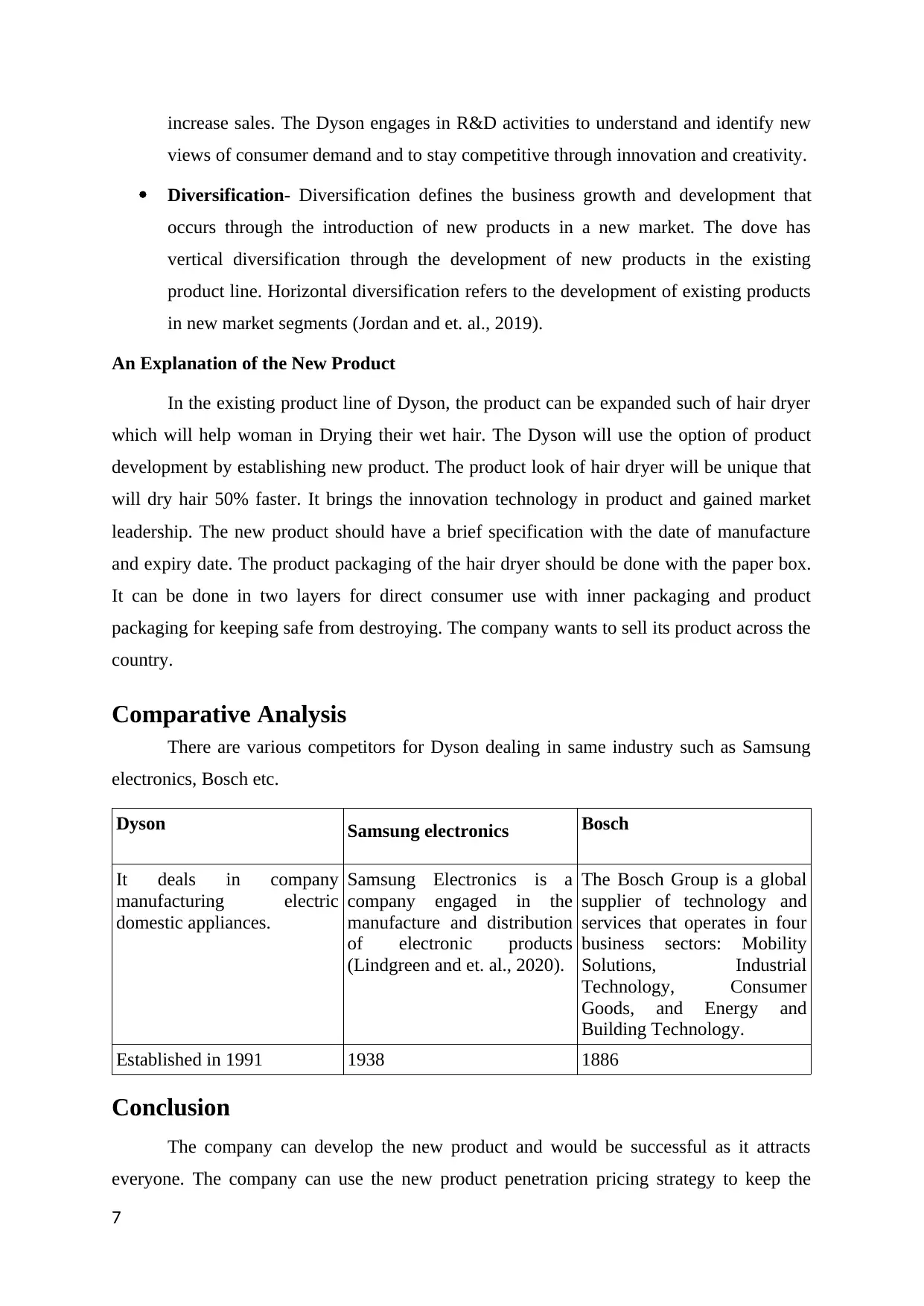
increase sales. The Dyson engages in R&D activities to understand and identify new
views of consumer demand and to stay competitive through innovation and creativity.
Diversification- Diversification defines the business growth and development that
occurs through the introduction of new products in a new market. The dove has
vertical diversification through the development of new products in the existing
product line. Horizontal diversification refers to the development of existing products
in new market segments (Jordan and et. al., 2019).
An Explanation of the New Product
In the existing product line of Dyson, the product can be expanded such of hair dryer
which will help woman in Drying their wet hair. The Dyson will use the option of product
development by establishing new product. The product look of hair dryer will be unique that
will dry hair 50% faster. It brings the innovation technology in product and gained market
leadership. The new product should have a brief specification with the date of manufacture
and expiry date. The product packaging of the hair dryer should be done with the paper box.
It can be done in two layers for direct consumer use with inner packaging and product
packaging for keeping safe from destroying. The company wants to sell its product across the
country.
Comparative Analysis
There are various competitors for Dyson dealing in same industry such as Samsung
electronics, Bosch etc.
Dyson Samsung electronics Bosch
It deals in company
manufacturing electric
domestic appliances.
Samsung Electronics is a
company engaged in the
manufacture and distribution
of electronic products
(Lindgreen and et. al., 2020).
The Bosch Group is a global
supplier of technology and
services that operates in four
business sectors: Mobility
Solutions, Industrial
Technology, Consumer
Goods, and Energy and
Building Technology.
Established in 1991 1938 1886
Conclusion
The company can develop the new product and would be successful as it attracts
everyone. The company can use the new product penetration pricing strategy to keep the
7
views of consumer demand and to stay competitive through innovation and creativity.
Diversification- Diversification defines the business growth and development that
occurs through the introduction of new products in a new market. The dove has
vertical diversification through the development of new products in the existing
product line. Horizontal diversification refers to the development of existing products
in new market segments (Jordan and et. al., 2019).
An Explanation of the New Product
In the existing product line of Dyson, the product can be expanded such of hair dryer
which will help woman in Drying their wet hair. The Dyson will use the option of product
development by establishing new product. The product look of hair dryer will be unique that
will dry hair 50% faster. It brings the innovation technology in product and gained market
leadership. The new product should have a brief specification with the date of manufacture
and expiry date. The product packaging of the hair dryer should be done with the paper box.
It can be done in two layers for direct consumer use with inner packaging and product
packaging for keeping safe from destroying. The company wants to sell its product across the
country.
Comparative Analysis
There are various competitors for Dyson dealing in same industry such as Samsung
electronics, Bosch etc.
Dyson Samsung electronics Bosch
It deals in company
manufacturing electric
domestic appliances.
Samsung Electronics is a
company engaged in the
manufacture and distribution
of electronic products
(Lindgreen and et. al., 2020).
The Bosch Group is a global
supplier of technology and
services that operates in four
business sectors: Mobility
Solutions, Industrial
Technology, Consumer
Goods, and Energy and
Building Technology.
Established in 1991 1938 1886
Conclusion
The company can develop the new product and would be successful as it attracts
everyone. The company can use the new product penetration pricing strategy to keep the
7
Paraphrase This Document
Need a fresh take? Get an instant paraphrase of this document with our AI Paraphraser
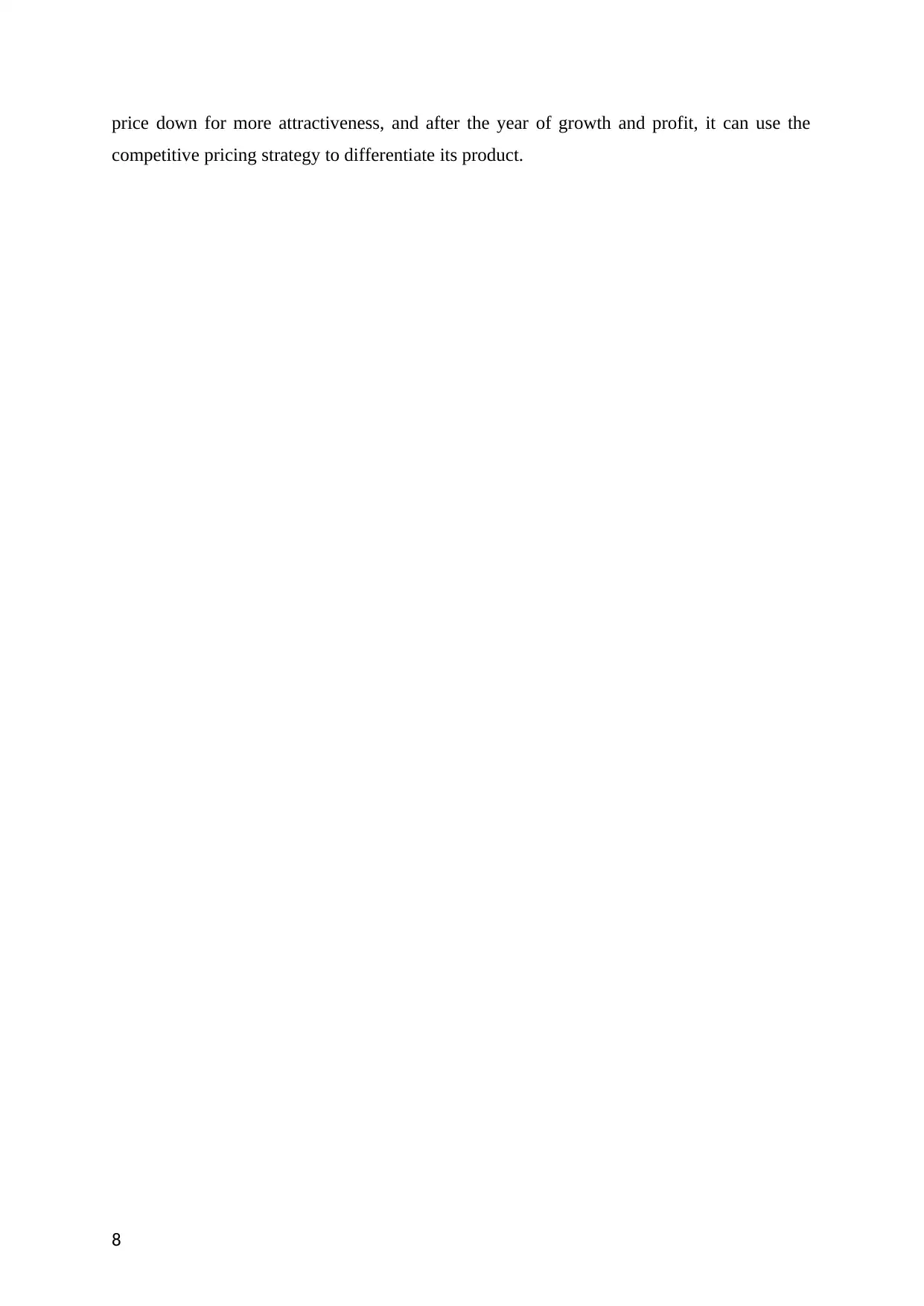
price down for more attractiveness, and after the year of growth and profit, it can use the
competitive pricing strategy to differentiate its product.
8
competitive pricing strategy to differentiate its product.
8
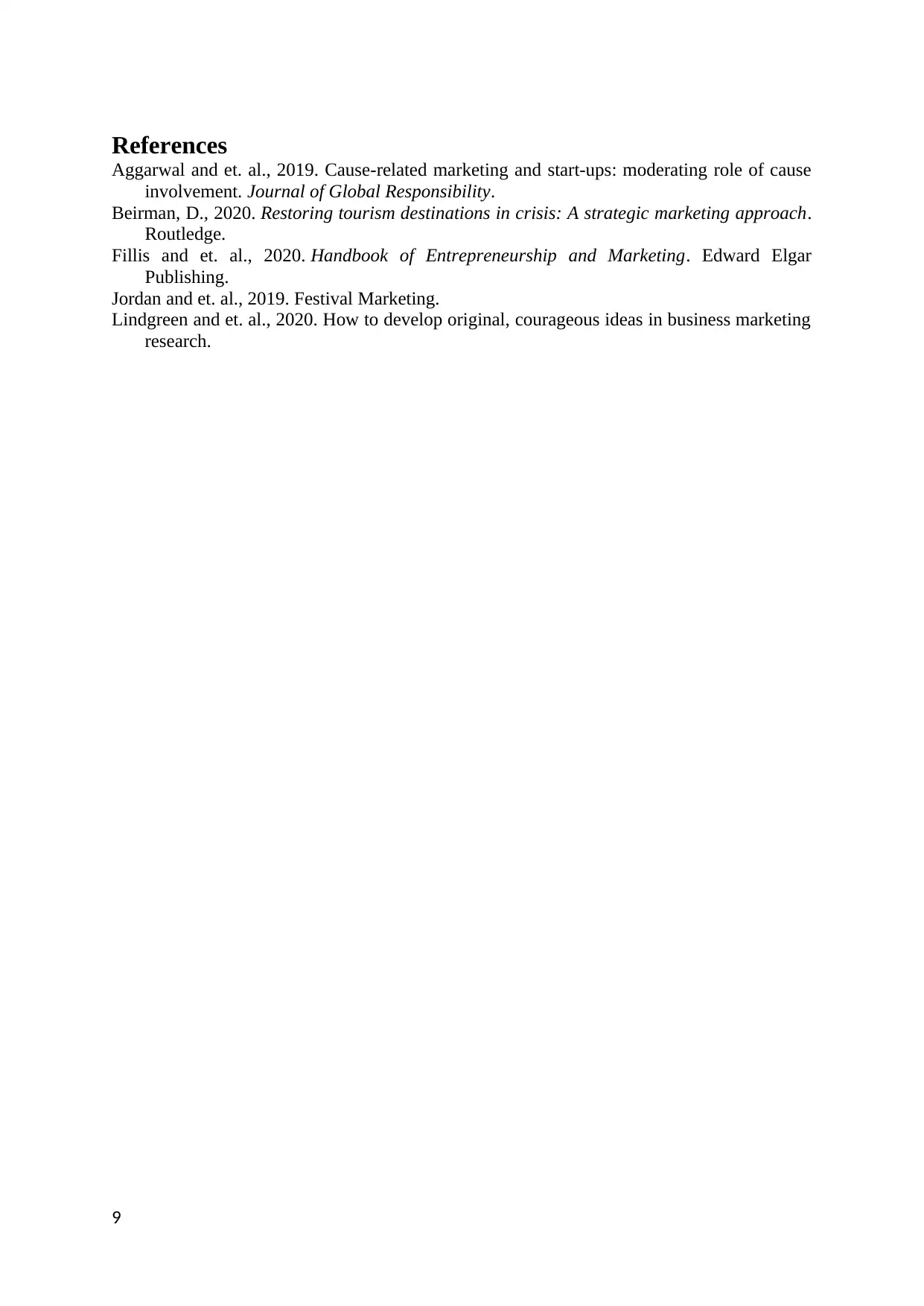
References
Aggarwal and et. al., 2019. Cause-related marketing and start-ups: moderating role of cause
involvement. Journal of Global Responsibility.
Beirman, D., 2020. Restoring tourism destinations in crisis: A strategic marketing approach.
Routledge.
Fillis and et. al., 2020. Handbook of Entrepreneurship and Marketing. Edward Elgar
Publishing.
Jordan and et. al., 2019. Festival Marketing.
Lindgreen and et. al., 2020. How to develop original, courageous ideas in business marketing
research.
9
Aggarwal and et. al., 2019. Cause-related marketing and start-ups: moderating role of cause
involvement. Journal of Global Responsibility.
Beirman, D., 2020. Restoring tourism destinations in crisis: A strategic marketing approach.
Routledge.
Fillis and et. al., 2020. Handbook of Entrepreneurship and Marketing. Edward Elgar
Publishing.
Jordan and et. al., 2019. Festival Marketing.
Lindgreen and et. al., 2020. How to develop original, courageous ideas in business marketing
research.
9
⊘ This is a preview!⊘
Do you want full access?
Subscribe today to unlock all pages.

Trusted by 1+ million students worldwide
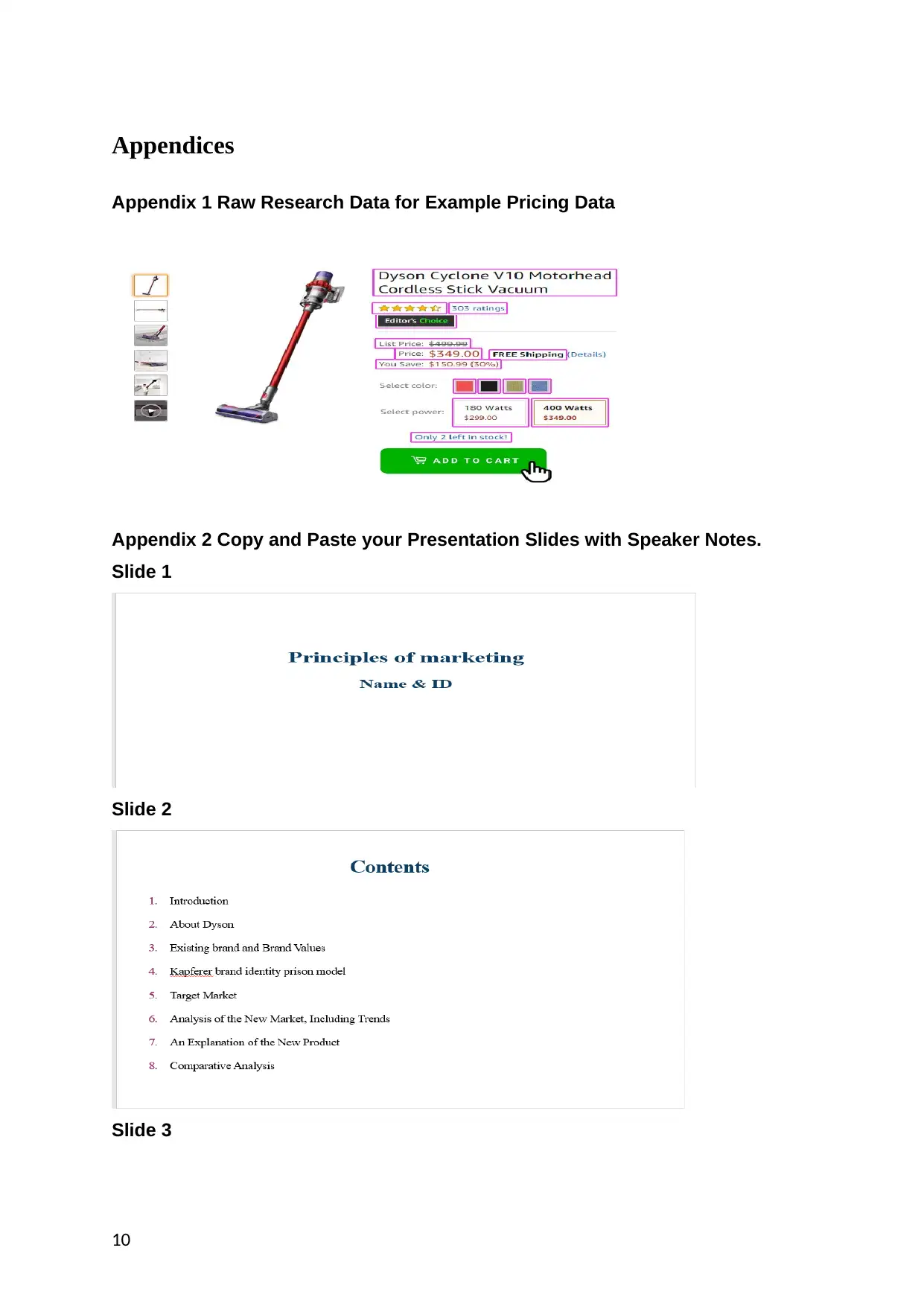
Appendices
Appendix 1 Raw Research Data for Example Pricing Data
Appendix 2 Copy and Paste your Presentation Slides with Speaker Notes.
Slide 1
Slide 2
Slide 3
10
Appendix 1 Raw Research Data for Example Pricing Data
Appendix 2 Copy and Paste your Presentation Slides with Speaker Notes.
Slide 1
Slide 2
Slide 3
10
Paraphrase This Document
Need a fresh take? Get an instant paraphrase of this document with our AI Paraphraser
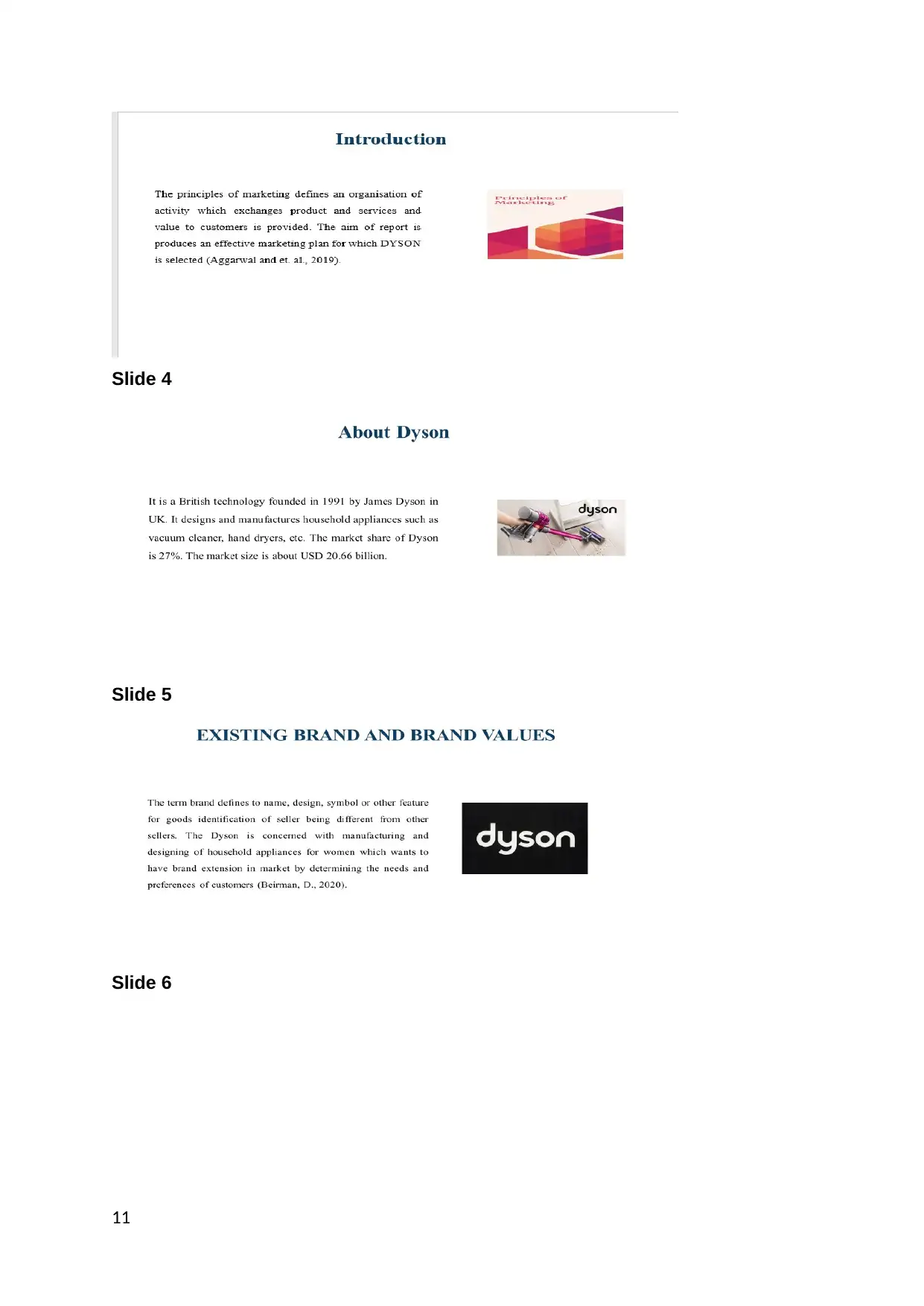
Slide 4
Slide 5
Slide 6
11
Slide 5
Slide 6
11
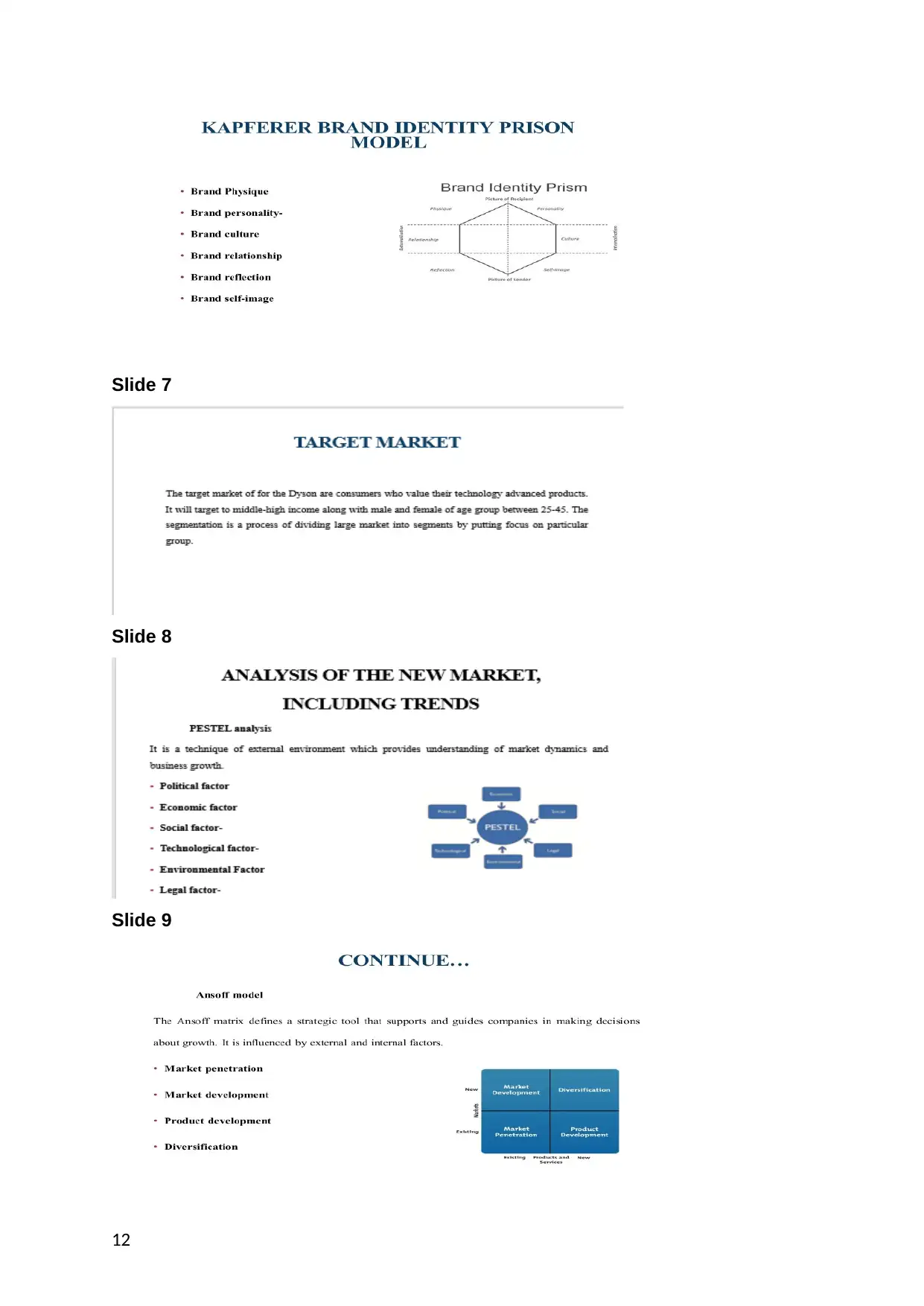
Slide 7
Slide 8
Slide 9
12
Slide 8
Slide 9
12
⊘ This is a preview!⊘
Do you want full access?
Subscribe today to unlock all pages.

Trusted by 1+ million students worldwide
1 out of 15
Related Documents
Your All-in-One AI-Powered Toolkit for Academic Success.
+13062052269
info@desklib.com
Available 24*7 on WhatsApp / Email
![[object Object]](/_next/static/media/star-bottom.7253800d.svg)
Unlock your academic potential
Copyright © 2020–2025 A2Z Services. All Rights Reserved. Developed and managed by ZUCOL.





